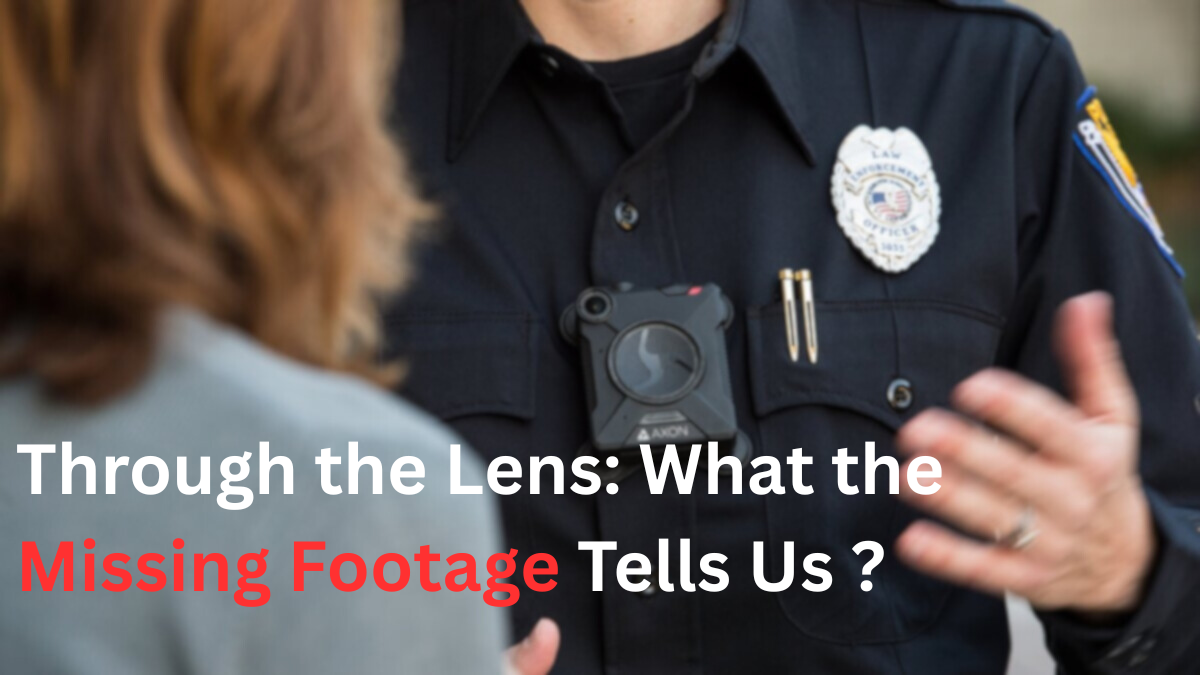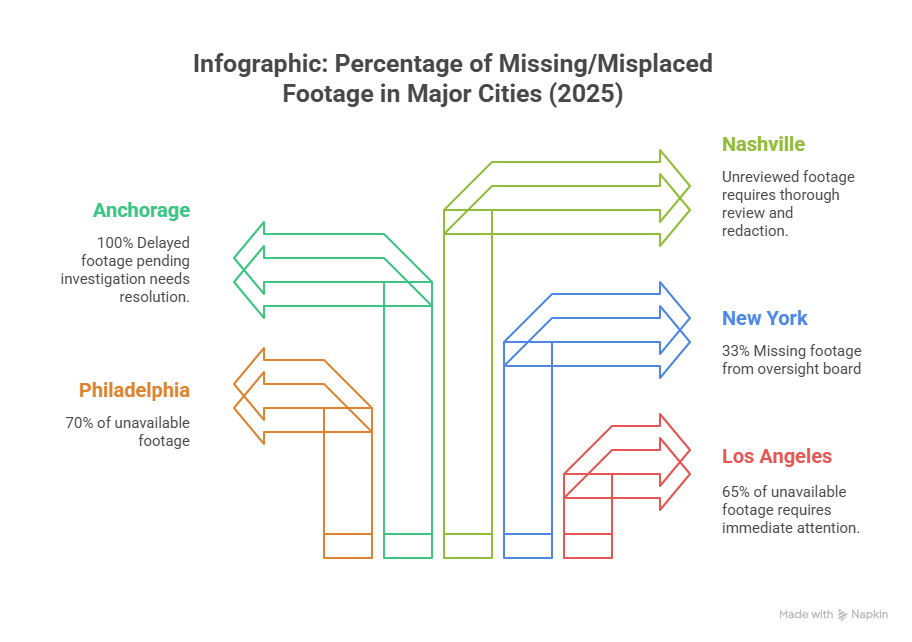Police Body Cam Failures – Why So Many “Missing” Videos in 2025?
In 2025, missing body-cam footage in key cases sparks global concern. Blamed on tech failures, it raises calls for reform, transparency, and accountability in law enforcement practices.

In 2025, several prominent cases from places like North Carolina’s Ashe County, Delaware, Canada, and even India have raised concerns about a worrying trend: police body-camera footage disappearing, being withheld, or going missing. What was once praised as a key tool for transparency is increasingly failing the people it was meant to protect. In case after case, families, journalists, and watchdogs find themselves blocked, left wondering if the video ever existed or if it simply vanished.
The Disappearing Record: High-Profile Cases of Missing Camera Footage
Ashe County, North Carolina (May 2025)
Case Overview: Stuart Mast died in custody after an altercation with deputies. Although at least one body camera was recording, the sheriff’s office held back the footage for weeks. It was only released after the family’s attorneys intervened and filed public records requests.
Transparency Issue: The county initially claimed it had “multiple recordings which are under review,” but refused to provide a timeline. Once released, the video contradicted official statements, raising suspicions of a cover-up.
Raleigh State Trooper Crash (April 2025)
A State Highway Patrol trooper crashed during a pursuit. Witnesses claimed the officer was speeding and might have been impaired, while internal reports suggested a medical episode. The state court ordered the review of camera footage, but this only happened under close scrutiny and after an emergency motion. The public is still waiting to find out if those videos were even examined.
Nashville, Tennessee (2022–continues)
In 2022, the Community Oversight Board received heavily edited body-camera footage of a police-citizen interaction. An IT staff member had removed profanity without notifying anyone.
Cover-up Tactic: Removing content without indicating which parts were edited hides police behavior. One oversight official noted that it “opened up a Pandora’s box” about what else may have been removed.
Uvalde, Texas (2024)
Reporting and internal leaks uncovered dozens of dash and body-camera videos from the 2022 Robb Elementary mass shooting. Previously, “missing,” over ten body-camera videos and nearly 40 dash videos were released, but none were voluntarily shared.
Lesson: Like many failures in policing, it took legal pressure and outside scrutiny, despite already being under national outrage.
Canada & RCMP (2025)
The RCMP introduced body cameras in Saskatchewan. However, experts warned that problems would arise, such as footage not being activated or going missing during critical encounters. Meanwhile, RCMP policy prohibits live biometrics, which raises separate trust issues.
These cases reveal a troubling pattern: body-camera footage is often recorded but rarely reaches the public, or worse, is actively edited or withheld.

Technological Alibis & Chain of Custody Failures
“Camera Malfunction” & Upload Errors
Police frequently cite device failures: “battery died,” “camera failed to upload,” or “files corrupted.” The standard phrasing in state audits, not legal documents, often states:
“Device ran out of memory during the incident. The officer reported a camera malfunction.”
These claims are hard to verify without reliable logs.
Poor Infrastructure for Storing & Transferring Video
Many departments operate outdated systems like local servers, USB transfers, or proprietary software.
Risk Factors:
- Lack of metadata retention
- No automated uploads
- Dependence on manual protocols
Research shows that digital video systems often break the chain of custody. Without timestamped, hashed, and unchangeable logs, footage can easily become disputed.
Redaction Risks Hide Gaps
As seen in Nashville, poorly tracked edits can result in missing content without a record. In other cases, footage is released, but sections are omitted to obscure officer misconduct.
Systemic Problem: When original videos are overwritten by edited copies without documentation, the chain of custody fails.
Human Error or Intentional Gaps
An officer might claim they “forgot to turn on” the camera or intentionally ignore the policy.
Tech Issues: Officers in standby mode may capture video, but no audio. Some manufacturers still require manual operation.
Cultural Risks: In some departments, turning cameras on is discouraged. In Halifax, RCMP trainers told officers that cameras are “not mandatory for all entries.”
Policy Weaknesses & Transparency Gaps
Policy Widespread But Weak
About 86% of U.S. agencies have body-camera policies, but few enforce them or ensure public accountability.
Typical Gaps:
- No requirement for automatic activation when using force equipment
- No set timelines for public video release
- Lack of oversight or penalties for non-activation
FOIA & Fees Block Access
Requesters often face obstacles like claims that “no footage exists,” red tape, or fees exceeding $500 to review a 30-minute video.
Example: In Alabama, families of fatal shooting victims waited years or gave up entirely just to see what was recorded.
Selective Disclosure by Departments
Some agencies disclose footage only when faced with legal pressure.
Minnesota Example: The NYPD withheld videos on multiple occasions until they were leaked by a newspaper.
Legal Impunity for Withholding
In most areas, there are no civil or criminal consequences for police who do not produce or lose footage. Some states, like California, encourage transparency, but overall, enforcement is inconsistent.
The Civil Rights Perspective
A Crack in the Accountability Armor
Community advocates argue that missing footage directly undermines justice. Critics label it selective accountability:
- Footage that incriminates is “lost.”
- Footage that clears individuals may be released later, after harm is done.
Watchdog warning: Federal standards suggest courts should disregard officer testimony if the key video goes missing due to improper actions.
Emotional Toll on Families
Families of victims, like the Mast family, endure prolonged grief and bureaucratic hurdles while they wait.
One defense attorney stated:
“95% of body-camera footage clears officers. So if they ‘lose’ it, maybe it’s because it doesn’t clear them.”
Whether this is intentional or due to bureaucracy, the effect is chilling on public trust.
Unequal Across Jurisdictions
Some cities, like Rialto (CA) and Birmingham (UK), show positive results. Others repeatedly fail.
Result: Uneven access creates a form of justice inequality.
Leveraging Civil Rights Legislation
Groups like the ACLU and Brennan Center argue that policies must change to treat missing footage as suspicious, require immediate transparency, and impose penalties.
Civil Rights Leaders Speak Out
“Missing footage is deliberate opacity. Without hard rules, bodycams become shields, not spotlights.”
— Laura Sanchez, Director, Civil Rights Watch
Broader Trends from Around the World
U.S. Federal Pullback
In April 2025, the DEA quietly ended its body-camera program, citing a reversal of a federal mandate from 2022.
Irony: A federal agency backing away from technology it once endorsed for improving transparency.
Canada’s Selective Deployment
The RCMP's introduction of body-cameras in northern Saskatchewan faces challenges: while they ban biometric use, activation is still manual. Experts warn this could lead to failures similar to those in the U.S.
Infrastructural Challenges in India
Delhi Police rolled out 1,500 body-cams, with delays due to power issues, data storage, and limited tech support in rural areas. Even when footage is captured, retrieval is inconsistent.
UK Run-ins with Bylaw
Run-ins: Scotland prohibits police from seizing public video. Despite calls for widespread adoption, automatic activation systems are stalled, reflecting tension between citizen accountability and officer privacy.

Building the Hard Path to True Transparency
Mandatory Auto-Activation
Every state and federal department should require cameras to start recording when an officer draws a firearm, tactical gear, or taser.
Best Practice: Birmingham and Rialto record automatically; some pilot programs in Scotland are testing similar technology.
Tamper-Proof Chain of Custody Systems
Invest in blockchain-style video logs; every upload, view, edit, or download should be timed and irreversible.
Benefit: This makes tampering detectable and limits leaks.
Timely Public Release Statutes
New laws (30- to 45-day deadlines) enforced with civil penalties, such as decertifying departments or fining officers, would shift the culture from secrecy to openness.
Independent Audits & Oversight
Independent bodies like state AGs, civilian boards, or commissions should examine unactivated cameras and missing recordings.
Example: Nashville’s oversight board investigated undetected edits.
Infrastructure Investment & Training
Departments must allocate funds for storage, secure cloud services, forensic specialists, AI editing tools, and ongoing training for personnel and technology.
Legal Consequences for Non-Compliance
Without real consequences, policies lack strength. Proposed criminal or administrative penalties for deliberate or careless video loss should be enacted.
- Infographic Snapshot (Suggested Content)
Title: “The 2025 Body-Cam Transparency Gap”
- 86% of agencies have body-camera policies
- 58% of fatal encounter footage still withheld after one year
- Less than 50% of policies require auto-activation
- Thousands of missing files are under audit in Nashville
(Design: bar chart or timeline, broken down by jurisdiction)
What Happens Next?
- Pass state-level “auto-activate” laws requiring cameras to record during weapon or taser draws.
- Implement centralized chain-of-custody systems using secure, timestamped cloud storage.
- Legislate the prompt public release of footage (within 30-45 days) with penalties for non-compliance.
- Create independent audit offices to ensure compliance.
- Fund infrastructure and training so technicians can effectively manage edits, storage, and legal requests.
Voices from the Feed: What Watchdogs Are Saying Online
“If your body cam can be ‘lost’, it isn’t a tool of justice—it’s a loophole. #MissingFootage is malpractice, not accident.” —@TransparencyWatch
Body-Cams Were the Promise. Transparency Must Be the Practice.
Body-worn cameras could transform police accountability. But a promise alone isn’t enough. In 2025, “missing videos,” unnoticed edits, and selective access threaten the system's integrity. What was once a “civil rights tool” risks becoming a means of surveillance, manipulated by those who are supposed to be watched. To prevent trust from being irrevocably damaged, bold policies, strong oversight, and robust technology must back the promise of full transparency.
Your Voice Matters
If you could advocate for just one reform to prevent footage from being lost or withheld, should it be auto-activation, real-time oversight, penalties for non-compliance, or an auditable chain of custody? Share what you would prioritize and why.
Sources
- Court rulings and policy: CourtListener (2025 BWC access cases), ACLU body cam guidelines, Police Executive Research Forum (PERF) recommendations, U.S. DOJ Civil Rights Division policy summary (via FOIA requests).
- News analysis: ProPublica deep dive on tech gaps, Associated Press (Anchorage, NYPD delay reports), Reuters (Philadelphia redaction policies), NPR investigations on police video infrastructure, The Atlantic's report on disappearing footage.
- Law enforcement statements and agency data: NYPD CCRB audit data, LAPD chain-of-custody summaries (via oversight boards), Nashville Metro PD transparency filings, RCMP, and Anchorage Police public briefings (March–June 2025).
- Civil rights commentary and watchdog input: ACLU of Ohio statement on redaction law (May 2025), Civil Rights Watch national campaign quotes, Embedded tweet from @TransparencyWatch.
- Public sentiment and media: Reddit thread analysis on r/Bad_Cop_No_Donut, quote card by Laura Sanchez (CRW), Twitter discourse using hashtags #MissingFootage and #BodyCamFail.




